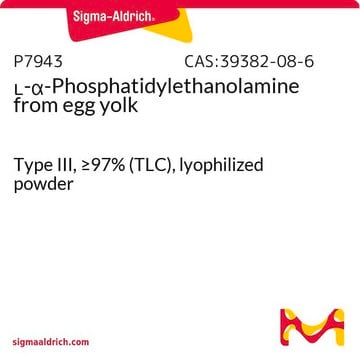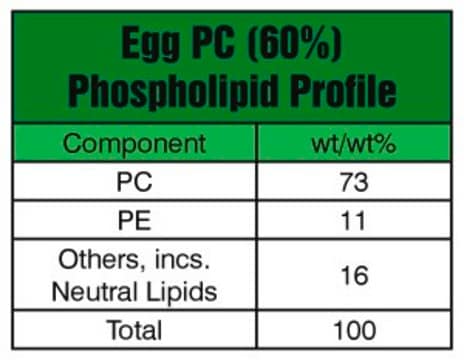P3531
1,2-Distearoyl-sn-glycero-3-phosphoethanolamine
≥99%
Synonyme(s) :
1,2-Dioctadecanoyl-sn-glycero-3-phosphoethanolamine, 3-sn-Phosphatidylethanolamine, 1,2-distearoyl, L-β,γ-Distearoyl-α-cephalin
About This Item
Produits recommandés
Pureté
≥99%
Forme
powder
Type de lipide
phospholipids
Température de stockage
−20°C
Chaîne SMILES
CCCCCCCCCCCCCCCCCC(=O)OC[C@H](COP(O)(=O)OCCN)OC(=O)CCCCCCCCCCCCCCCCC
InChI
1S/C41H82NO8P/c1-3-5-7-9-11-13-15-17-19-21-23-25-27-29-31-33-40(43)47-37-39(38-49-51(45,46)48-36-35-42)50-41(44)34-32-30-28-26-24-22-20-18-16-14-12-10-8-6-4-2/h39H,3-38,42H2,1-2H3,(H,45,46)/t39-/m1/s1
Clé InChI
LVNGJLRDBYCPGB-LDLOPFEMSA-N
Vous recherchez des produits similaires ? Visite Guide de comparaison des produits
Application
- Injectable Composite Hydrogels Embedded with Gallium-Based Liquid Metal Particles for Solid Breast Cancer Treatment via Chemo-Photothermal Combination.: This article presents the use of DSPE in developing injectable composite hydrogels. These hydrogels are embedded with liquid metal particles to provide a dual-mode treatment approach combining chemotherapy and photothermal therapy for breast cancer (Lee et al., 2024).
Code de la classe de stockage
11 - Combustible Solids
Classe de danger pour l'eau (WGK)
WGK 3
Point d'éclair (°F)
Not applicable
Point d'éclair (°C)
Not applicable
Équipement de protection individuelle
Eyeshields, Gloves, type N95 (US)
Certificats d'analyse (COA)
Recherchez un Certificats d'analyse (COA) en saisissant le numéro de lot du produit. Les numéros de lot figurent sur l'étiquette du produit après les mots "Lot" ou "Batch".
Déjà en possession de ce produit ?
Retrouvez la documentation relative aux produits que vous avez récemment achetés dans la Bibliothèque de documents.
Les clients ont également consulté
Notre équipe de scientifiques dispose d'une expérience dans tous les secteurs de la recherche, notamment en sciences de la vie, science des matériaux, synthèse chimique, chromatographie, analyse et dans de nombreux autres domaines..
Contacter notre Service technique












